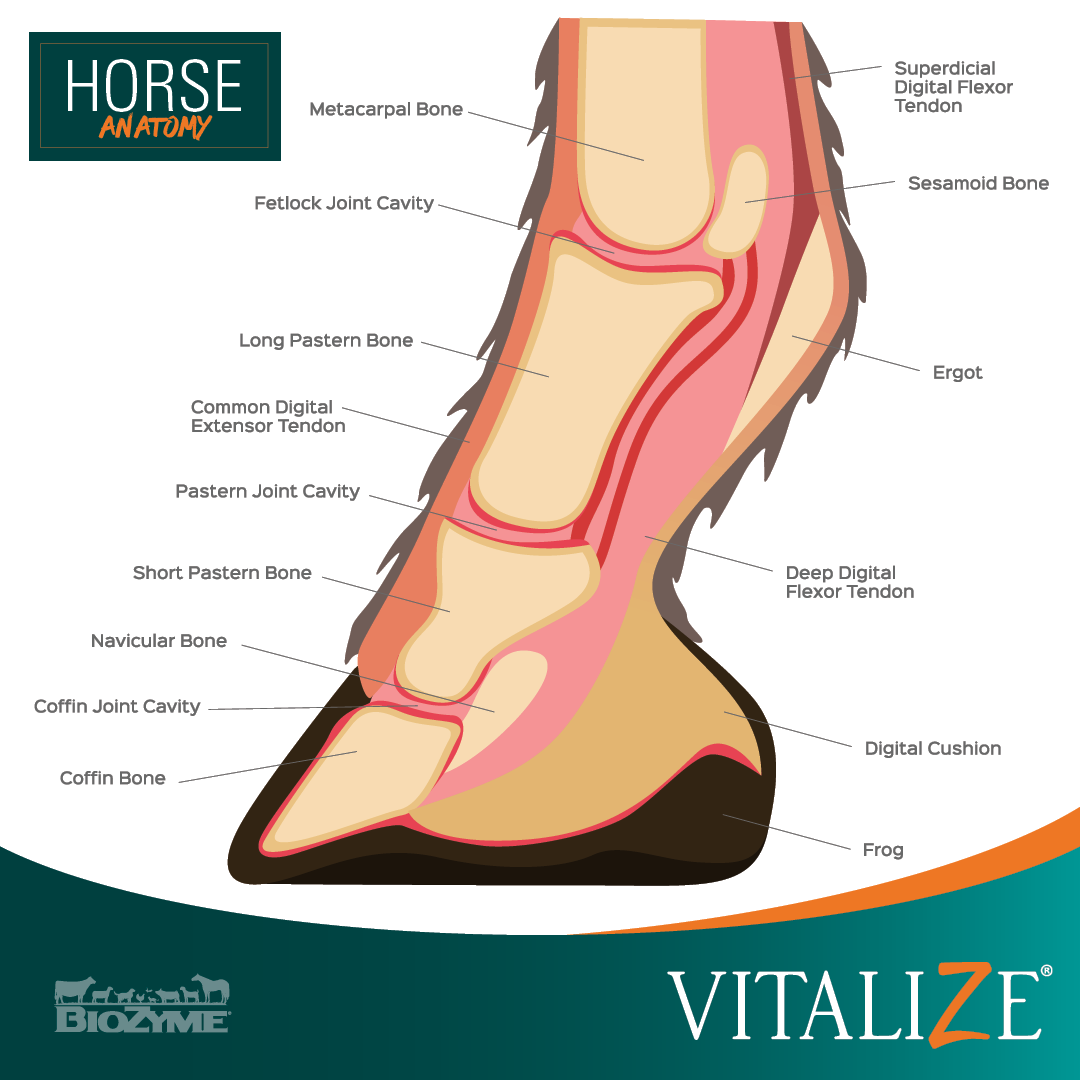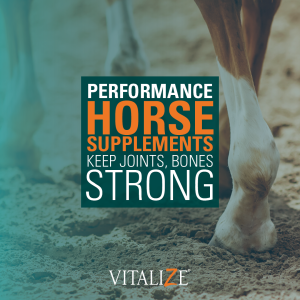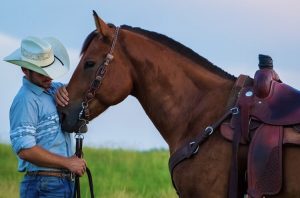
We can’t care for what we don’t understand. And when it comes to caring for our equine companions, two things are of upmost importance – their gut health and their legs. Understanding horse leg anatomy is crucial for maintaining your animal’s bone and muscle health and overall soundness.
When it comes to a horse’s leg, there is more than meets the eye. The leg is a complex structure of bones, joints, muscles, tendons, and ligaments.
At Vitalize®, our team is filled with horse lovers just like you. That is why we take horse health so seriously. We want to make sure our horses and yours are feeling their best so they can perform to their optimum. Whether they are performance horses or purely for companionship and enjoyment, your horse deserves the best life possible.
Who is Vitalize?
We wouldn’t trust just anyone to give us advice on caring for our horses. We suspect you’re probably the same. Here’s what you need to know about Vitalize.
Vitalize is a line of supplements for horses, dogs and cats with proven solutions to keep your animal healthy and performing. We are a renowned brand of supplements designed to enhance equine health, provide a good gut feeling and support bone, joint and soft tissue health. Vitalize products support equine enthusiasts from the ranch horse owner on the Western plains to the Olympic jumper to those in between.
The Vitalize brand is developed by BioZyme® Inc., a global fermentation company pioneering advancements in animal nutrition and health. Through innovative research and high-quality manufacturing, BioZyme creates powerful solutions that improve animal performance.
Our mission: undeniable positive impact on the health and wellness of your animals.
Understanding Horse Leg Anatomy
Before we can really understand how to keep our horses structurally sound, we better know the parts of their body that impact performance. Feet and legs have a huge impact on bone and joint health, and there is often more going on internally than what meets the eye.
Let’s quickly review horse leg anatomy and its various components. This will be helpful when working with your veterinarian or trainer. We always recommend building a strong relationship with your veterinarian; it makes caring for your horse easier and safer. They will be glad to know that you know horse leg anatomy when discussing any challenges.
Bones

The first part of the anatomy we will examine is the bones of the horse. Working from front to back and top to bottom, we’ll discuss the various bones that make up the anatomy of a horse leg.
Forearm
Scapula:
- Common name is Shoulder Blade
- Connects the forelimb to the body.
Humerus
- Runs from the shoulder to the elbow
Radius & Ulna
- Forms the forearm
- Radius is the primary weight-bearing bone
Carpal Bones
- Forms the knee in the forelimb
- Equivalent to the human wrist
Metacarpal Bones
- Commonly known as the cannon bone and the splint bones.
Phalanges
- The lower part of the limb – same on front and hind limb
- Comprised of the long pastern bone, short pastern bone and coffin bone
Back Leg or Hind Limb
Pelvis
- The large bony structure that forms the hip region
- Connects the hind limbs to the spine
Femur
- The thigh bone
- Runs from the hip joint to the stifle joint
Patella
- Might also be called the kneecap
- A small bone that sits in front of the stifle joint
Tibia & Fibula
- Tibia is the larger bone of the lower leg, running from the stifle joint to the hock
- Fibula is smaller, often fused with the tibia in horses
Tarsal Bones
- Forms the hock, equivalent to the human ankle
- The largest tarsal bone is the calcaneus, which forms the point of the hock
Metatarsal Bones
- Similar to the metacarpals in the front leg
- Form the cannon bone and the splint bones of the hind leg
Forearm Joints

The horse’s forearm consists of several joints that work cohesively to move and stretch. These joints, along with their associated bones, muscles, and tendons, are crucial for the horse’s mobility and function.
The primary joints in the forearm of the horse include:
Shoulder Joint (Scapulohumeral Joint
This is the joint between the scapula (shoulder blade) and the humerus (upper arm bone). It allows for a wide range of motion in the horse’s forelimb.
Elbow Joint (Humeroradioulnar Joint)
Located between the humerus and the radius and ulna bones, this joint primarily allows the forelimb to flex and extend.
Knee Joint (Carpal Joint)
The carpal joint, usually referred to as the horse’s knee, is a complex joint. It consists of three main joints:
- Radiocarpal Joint: Between the radius and the proximal row of carpal bones.
- Intercarpal Joint: Between the two rows of carpal bones.
- Carpometacarpal Joint: Between the distal row of carpal bones and the metacarpal bones.
Hind Limb Joints
The hind limb also contains several primary joints that play crucial roles in movement, stability and overall locomotion. Here are the main joints:
Hip Joint (Coxofemoral Joint)
Allows for a wide range of motion including flexion, extension, abduction and rotation.
Stifle Joint (Femorotibial Joint)
It functions similar to the human knee and includes the patellar ligaments and menisci for stability.
Hock Joint (Tarsal Joint)
Acts like the human ankle, providing flexibility and shock absorption during movement. It has three components:
- Tibiotarsal Joint: Between the tibia and the talus.
- Intertarsal Joints: Between the different tarsal bones.
- Tarsometatarsal Joint: Between the distal tarsal bones and the metatarsal bones.
Fetlock Joint (Metatarsophalangeal Joint)
It is crucial for the horse’s gait, as it provides shock absorption and flexibility.
Pastern Joint (Proximal Interphalangeal Joint)
Adds to the hind limb’s flexibility and helps in shock absorption.
Coffin Joint (Distal Interphalangeal Joint)
Facilitates the horse’s weight distribution and movement, particularly in the hoof.
Muscles & Ligaments
The muscles and tendons in horses’ legs are essential for movement, strength, stability and shock absorption.
There are two primary groups of muscles and tendons in the horse’s legs.
Muscles
- Extensor Muscles: Allow the leg to extend forward.
- Flexor Muscles: Allow the leg to bend.
Ligaments
- Suspensory Ligament: Supports the fetlock and prevents overextension.
- Superficial and Deep Digital Flexor Tendons: Run down the back of the leg, crucial for movement and support.
Bone & Muscle Health
Now that you understand horse leg anatomy, we can discuss the importance of maintaining quality bone and muscle health in your horse. Why is this important? Your horse’s bones and muscles are likely carrying precious cargo—you! And if you are competing, working livestock, or just enjoying a ride in the prairie or arena, you want your horse to feel its very best!
Bone and muscle health can best be achieved by taking a proactive approach. Prevention is the best medicine, so taking care of your horses before anything needs treatment is the best suggestion we can offer to maintain soundness. Yes, challenges do occur, and that is why it is so important to have a good relationship with your veterinarian.
Let’s discuss some ways to remain proactive in your horse’s bone and muscle health.
Bone Health
Nutrition
A balanced diet with adequate levels of calcium, phosphorus and vitamin D is essential for bone health. Calcium and phosphorus are critical for bone density, while vitamin D aids in their absorption.
Exercise
Regular, controlled exercise helps to strengthen bones and maintain their density. Exercise also helps with maintaining soundness and is a way to evaluate for it.
Injury Prevention
Proper hoof care, correct shoeing and avoiding excessive strain can prevent fractures and bone diseases.
Muscle Health
Diet
Protein is vital for muscle repair and growth. Amino acids like lysine and methionine are particularly important. Ensure a diet rich in high-quality forage, and if needed, supplements.
Hydration
Adequate water intake is essential for muscle function and overall health.
Exercise
Regular exercise helps maintain muscle tone and flexibility. A combination of cardiovascular work and strength training is ideal.
Massage & Stretching
Regular massage and stretching can improve muscle elasticity and blood flow, aiding in recovery and reducing the risk of injury.
Rest & Recovery
Allowing time for muscles to rest and recover after exercise is crucial for preventing overuse injuries.
Common Bone, Muscles Issues & Prevention
Lameness
Lameness can result from a variety of issues, including arthritis, tendonitis, or fractures. Watch for any irregularities in gait, such as limping. Regular vet check-ups and monitoring for signs of discomfort can help in early detection and treatment. As we mentioned earlier, soundness can be detected during daily exercise.
Prevention:
- Focus on hoof health
- Pick your horse’s hooves daily for any mud, dirt or manure build up
- Avoid working or riding your horse on a hard surface
Laminitis
Laminitis is damage and inflammation of the tissue between the hoof and the underlying coffin bone. It can lead to founder if not treated quickly and properly.
Prevention:
- Avoid high-sugar diets and select feeds that are low in non-structural carbohydrates (NSC)
- Limit over-grazing on green, lush pastures, especially during the high-sugar times
- Make any dietary changes gradually
- Consider supplements that support hoof health, such as biotin, methionine and zinc
- Provide proper hoof care
Osteoarthritis
Osteoarthritis is the deterioration of a joint or joints that is characterized by progressive loss of joint cartilage.
Prevention:
- Adequate exercise
- Weight management
- Certain joint supplements
Equine Health Starts with Good Nutrition
Regardless of if we are talking overall health or bone and muscle health, we hope you can see all equine health starts with good nutrition. That’s how Vitalize supplements can help you achieve the results you are looking for.
We know that 70% of the immune response starts in the gut. That is why a majority of our products contain AO-Biotics® Amaferm ®, a research-proven prebiotic designed to enhance digestibility. By keeping the horse’s digestive system healthy, and feeding supplements that are low in NSC, you are taking the first step in overall equine health. A healthy horse is more likely to have healthy feet and legs, keeping them feeling good and sound. But wait, there is more!
Vitalize Can Help!
Vitalize is a line of supplements for horses, dogs and cats with proven solutions to keep your animal healthy and performing.
At BioZyme, we know how important joint health and soundness is too all species. Therefore, we utilize the gold standard of hyaluronic acid (HA) – MHB3® Hyaluronan. MHB3 is a primary ingredient in Vitalize® Hyaluronex® Joint for horses.
Vitalize Hyaluronex Joint is a liquid product for horses designed to support sustainable soundness using hyaluronic acid and antioxidants. Hyaluronex Joint helps maintain a normal inflammatory response and supports normal exercise recovery. It supports bone, joint and soft tissue health. But most importantly, it contains MHB3, a high molecular weight hyaluronic acid that holds 8 U.S. Patents.
What Makes MHB3 Different?
Yes, there are many hyaluronic acids on the market. However, what makes MHB3 unique is its liquid formulation. Because HA molecules are extremely water-loving, they can hold up to 1,000 times their weight in water.
Dry forms of HA (pills, tablets, capsules & powders) do not have enough time to fully hydrate before being passed through the body’s digestive tract. Essentially, the body struggles to absorb dry forms, making them much less effective.
The primary absorption points for HA throughout the body are in the mucosal tissue of the mouth and the upper parts of the throat. To take advantage of the absorption points, the product must be bioavailable for immediate absorption as soon as it hits your horse’s mouth.
Giving your horses just two pumps of Vitalize Hyaluronex per day may help reduce inflammation in horses due to exercise, training and competition. Support a normal inflammatory response with Hyaluronex Joint and give your horses the joint support they need and deserve.
Give your Horses a Good Gut Feeling & Sustainable Soundness
As we mentioned at the beginning of the blog, digestive and leg health are of the utmost importance to horses and their owners. Understanding horse leg anatomy can help prevent issues and ensure your equine companion keeps performing comfortably. We’ve told you about our joint health supplement, Vitalize Hyaluronex Joint, but did you know that Vitalize offers a plethora of other supplements for horses, too?
It’s time to add Vitalize to your feed room. You can purchase it online on our website or through one of BioZyme’s online retailers.
If you want to shop locally, you can search for your local BioZyme dealer on our website.
We offer a plethora of other products and educational information through a monthly email. Sign up now to receive that information.
You can also view all the other Vitalize equine and canine products on our website.

